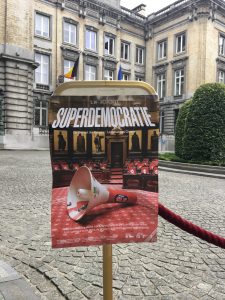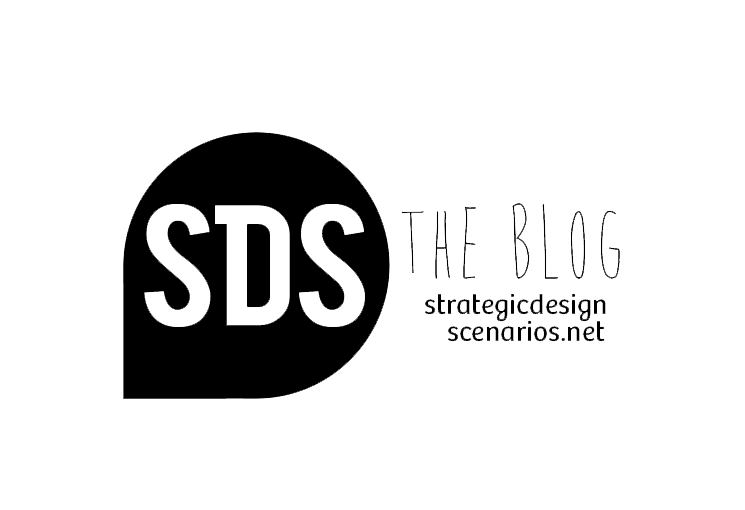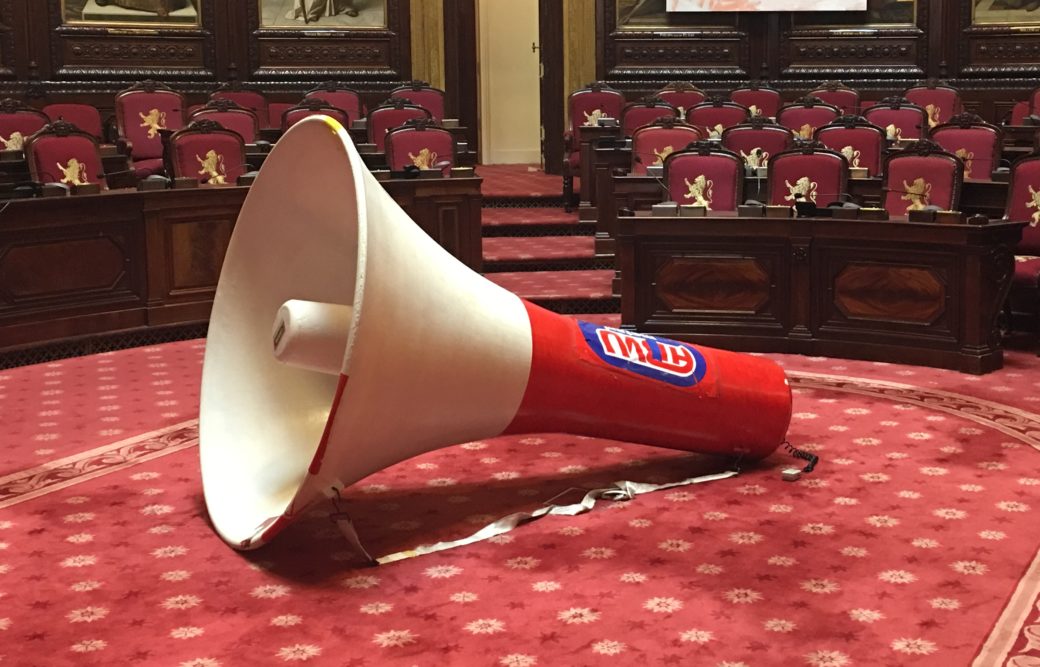
(English version below)
Le Sénat de Belgique accueille SUPERDEMOCRATIE du 1er au 31 octobre 2017.
Initiative conjointe de M HKA, BPS 22, BOZARS et VUB CROSSTALKS cette exposition présente des œuvres contemporaines et des commentateurs invités autour des thèmes INVESTIGATIO, CONCORDIA, CONCINNARE, SALUS, INVENTIO, IN SOLIDUM, DIVERSITAS (IN SAMENHANGEN), RADIX, DIVERSITAS, OECONOMIA, DIVERSITAS (GENDER) et MOBILITAS.
On ne peut que saluer cette initiative en ces temps de menaces de nos démocraties. Investir le Sénat de Belgique pour poser l’hypothèse d’une SUPERDEMOCRATIE élargie aux mouvements croissants de démocratie délibérative, englobant l’idée du « Parlement des choses » de Bruno Latour, etc. est une action de la plus haute importance surtout quand on sait la remise en question des institutions fédérales aujourd’hui dans ce pays.
Cette initiative permet d’abord de faire entrer le public dans les institutions qui le représentent et auxquelles il n’a que rarement accès. Elle permet aussi de confronter les dirigeants politiques avec les questionnements posés par les artistes.
SUPERDEMOCRATIE nous semble aussi poser la question de l’actionabilité de ces démarches et de leurs capacités de transformation effective de la gouvernance. SDS était invité à parler sur le thème INVENTIO. Vous trouverez ici le texte complet de notre intervention critique ainsi que les œuvres qui illustrent le thème INVENTIO.

INVENTIO @ SUPERDEMOCRATIE…
Le texte introductif du thème inventio nous dit :
“l’invention est probablement le trait le plus saillant de l’art; particulièrement depuis l’art moderne. Mais inventer n’est pas l’apanage exclusif de l’art : toute société, pour évoluer, pour répondre à ses besoins, doit inventer… »
L’art nourrit et inspire l’inventio societal. Dans ma pratique professionnelle qui a à voir avec cet inventio societal, avec le design, l’innovation sociale, le développement durable l’inventio participe des mêmes élans mais il ne me semble pourtant pas se comprendre tout à fait de la même manière.
Voici quelques exemples de l’inventio dont je parle pour vous permettre de mieux saisir mon point de vue :
Il y a d’abord l’inventio des gens en matière de collaboration entre citoyens : dans le projet CoJardinage, par exemple pour que tous les jardins privés de Bruxelles produisent des fruits et des légumes, nous cherchons avec Bruxelles Environnement comment stimuler l’inventio des propriétaires de jardins qui n’ont pas la main verte pour qu’il rencontre l’inventio des jardiniers amateurs qui n’ont pas la chance d’avoir leur propre jardin pour plus d’agriculture urbaine et de cohésion sociale dans la Région Bruxelles Capitale.
Il y a aussi l’inventio des villes en matière d’innovation et de politiques publiques : dans le projet « REFILL the city« , un réseau européen URBACT sur comment « remplir » tout les bâtiments vides ou inoccupés dans les villes, nous organisons pendant 3 ans des échanges entre la ville de Gand, Amersfoort, Athènes, Bremen, Cluj, Helsinki, Nantes, Ostrava, Poznan et Riga, soit 10 villes européennes engagées dans l’usage temporaire des espaces vacants, qui rivalisent d’inventio pour héberger des initiatives citoyennes, des projets sociaux, environnementaux ou entrepreneuriaux.
Il y a l’inventio des pouvoirs publics en matière de gouvernance et d’administration : dans le projet avec le Service Publique de Wallonie, de co-construction d’un labo d’innovation publique à la Direction Générale Economie, Emploi et Recherche, nous cherchons comment mobiliser l’inventio des agents du service public pour produire par eux-mêmes une administration plus orientée usagers et plus fluide.
Enfin un dernier exemple : l’inventio des citoyens européens et de la Commission Européenne en matière de co-production de l’avenir : dans le projet CIMULACT, un projet recherche Horizon 2020 visant à intégrer la société dans les questions de science et d’innovation, nous co-construisons une plateforme délibérative pour mettre en résonance l’inventio des citoyens pour formuler des visions souhaitables de la société dans laquelle ils voudraient vivre avec l’inventio des scientifiques de tous les domaines de recherche afin d’orienter les politiques scientifiques de la Commission Européenne vers la réalisation de ces visions et vers une gouvernance qui prenne mieux en compte les gens.
Ce sont pour moi peut-être quelques modestes formes naissantes de cette SUPERDEMOCRATIE qui est le focus de cet événement.
Je reviens maintenant sur ma discussion de l’inventio et de certaines des œuvres qui l’illustrent ici :
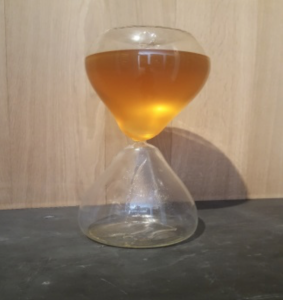
Honey bell nous alerte sur l’hyper-vitesse mais elle ne nous dit pas comment ralentir notre société.
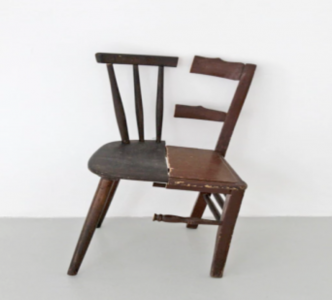
Chaise découpée nous indique la déviation, l’accident, le cadavre exquis comme moteurs de l’invention, mais la disruption ne suffit pas pour mettre au point une solution adaptée tenant compte de toutes les parties prenantes.
L’inventio qui m’anime, celui de l’innovation sociale ou du design d’un quotidien plus durable n’est pas dénonciateur, ironique ou provoquant. Il cherche au contraire dans la résolution patiente, dans l’empathie avec les contradictions du monde, dans le compromis qui rassemble, etc. Il cherche des solutions praticables pour le quotidien des gens, pour ralentir le temps ou pour habiliter chacun à inventer !
François Jégou

(version française ci-dessus)
The Senate of Belgium welcomes SUPERDEMOCRACY from 1 to 31 October 2017.
This joint exhibition of M HKA, BPS 22, BOZARS and VUB CROSSTALKS hosts contemporary artworks and invited commentators on the themes of INVESTIGATIO, CONCORDIA, CONCINNARE, SALUS, INVENTIO, IN SOLIDUM, DIVERSITAS IN SAMENHANGEN, RADIX, DIVERSITAS, OECONOMIA, DIVERSITAS (GENDER) and MOBILITAS.
We can only welcome this initiative in these times of threats of our democracies. Investing the Belgian Senate to pose the hypothesis of a SUPERDEMOCRACY enlarged to the growing movements of deliberative democracy, including the « Parliament of Things » by Bruno Latour is an action of the highest importance especially when we know the questioning of federal institutions today in this country.
This initiative firstly brings the public into the institutions that represent it and to which it rarely has access. It also makes it possible to confront the political leaders with the questions posed by the artists.
It also seems to us to raise the question of the actionability of these approaches and their capacities for the effective transformation of governance. SDS was invited to speak on INVENTIO. You will find here the complete text of our critical intervention as well as the artworks that illustrates the theme INVENTIO.
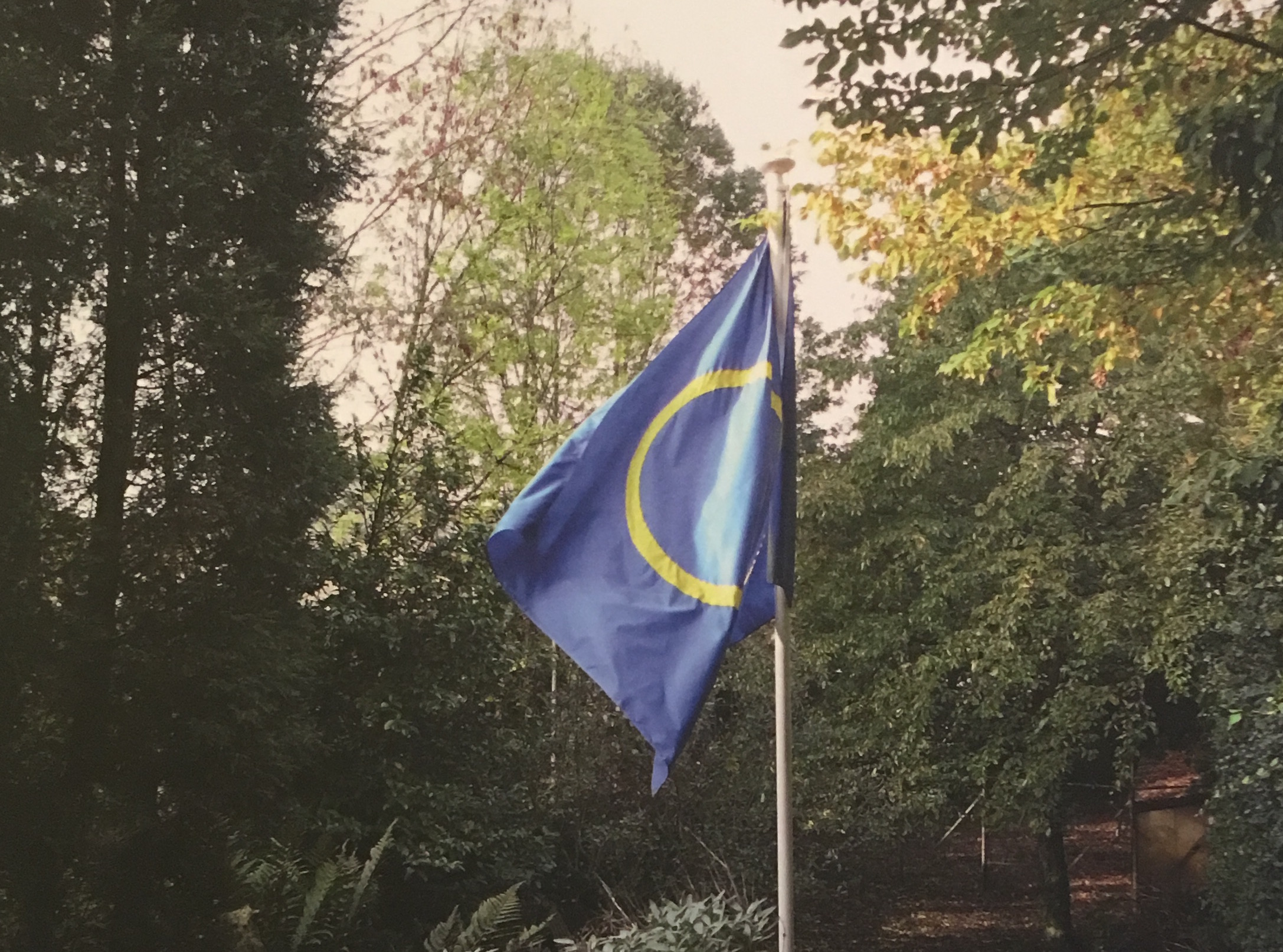
INVENTIO @ SUPERDEMOCRATIE…
The introductory text of the inventio theme tells us:
« Invention is probably the most salient feature of art; especially since modern art. But to invent is not the exclusive prerogative of art: any society, to evolve, to meet its needs, must invent… «
Art nourishes and inspires the societal inventio. In my professional practice which has to do with this societal inventio, with design, social innovation, sustainable development, the inventio participates of the same impulses but it does not seem to me however to be understood quite in the same way.
Here are a few examples of the inventio I am talking about for you to better understand my point of view:
There is first of all the inventio of people in terms of collaboration between citizens: in the CoJardinage project, for example, to ensure that all private gardens in Brussels produce fruits and vegetables, we are seeking, with Brussels Environnement, how to stimulate the inventio of garden owners who do not have the green hand to meet the inventio of amateur gardeners who do not have the chance to have their own garden for more urban agriculture and social cohesion in the Brussels Capital Region.
There is also the inventio of cities in public policy innovation: in the project « REFILL the city« , an URBACT European network on how to « refill » all the empty or unoccupied buildings in the cities, we organize exchanges between the cities of Ghent, Amersfoort, Athens, Bremen, Cluj, Helsinki, Nantes, Ostrava, Poznan and Riga, 10 European cities engaged in the temporary use of vacant spaces, which compete inventio to host citizen initiatives, social, environmental or entrepreneurial projects.
There is the government’s inventio in governance and administration: in the project with the Public Service of Wallonia, co-construction of a public innovation lab at the General Direction Economy, Employment and Research, we seek how to mobilize the inventio of civil servants to produce by themselves a more user-oriented and more fluid administration.
Last a final example: the inventio of European citizens and the European Commission in the matter of co-production of the future: in the CIMULACT project, a Horizon 2020 research project aimed at integrating society into science and innovation issues, we are co-constructing a deliberative platform to bring citizens’ inventio together to formulate desirable visions of society in which they would like to live with the inventio of scientists from all fields of research in order to guide the scientific policies of the European Commission towards the realization of these visions and towards governance that takes better account of people.
These are for me perhaps a few modest emerging forms of the SUPERDEMOCRACY that the all event is about.
I return now to my discussion of the inventio and some of the art works, which illustrate it here:

Honey bell alerts us about hyper-speed but it does not tell us how to slow down our society.

Cut-off chair indicates the deviation, the accident, the exquisite corpse as motors of the invention, but the disruption is not sufficient to develop an adapted solution taking into account all the stakeholders.
The inventio that animates me, that of social innovation or of the design of a more sustainable daily living is not denouncing, ironic or provocative. It seeks, on the contrary, in patient resolution, in empathy with the contradictions of the world, in the compromise, which brings together, and so on. It seeks practical solutions for everyday life, to slow down time or to empower everyone to invent!
François Jégou
